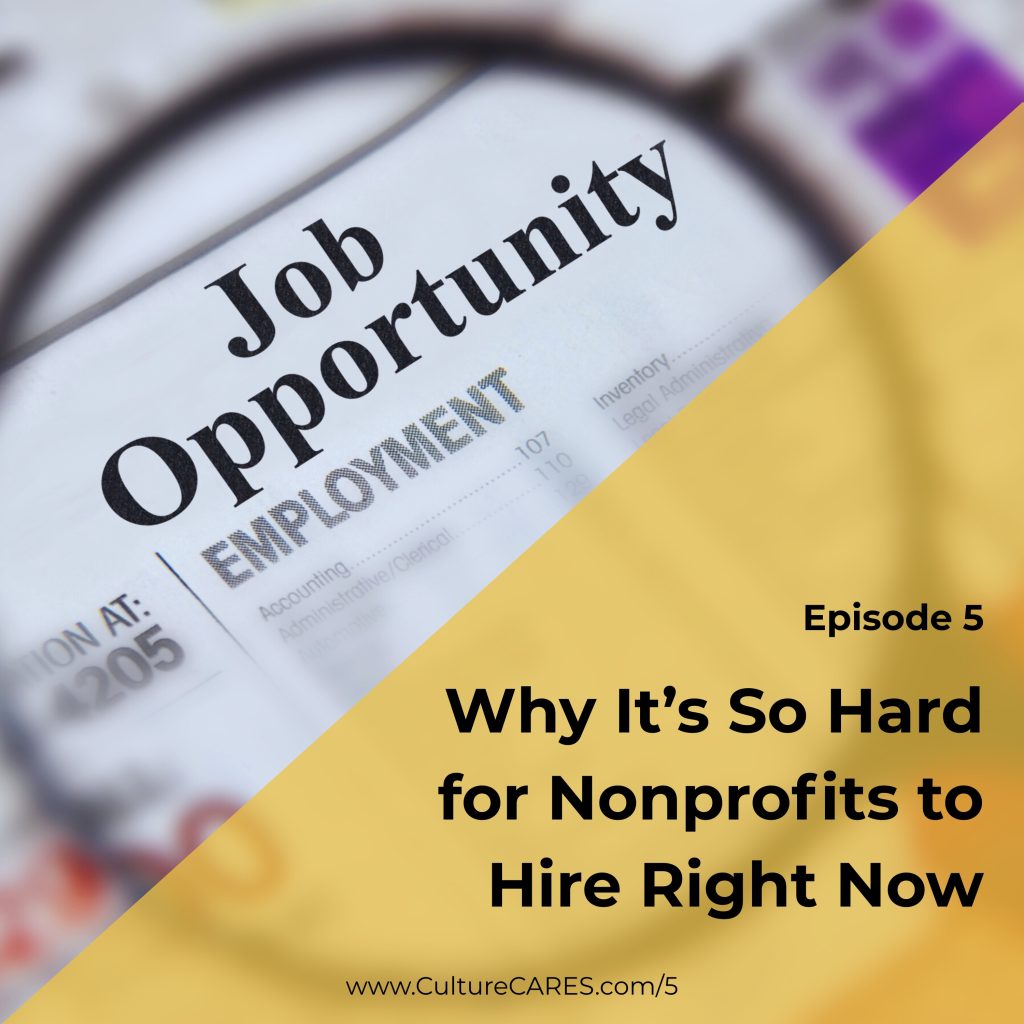Hey there, nonprofit CEOs and executive directors. Welcome back to Nonprofit CEO SPARK, the show that fuels your leadership, protects your energy, and helps you spark lasting change.
Let me paint the picture.
You spend three hours writing a job posting. You list all the “must-haves,” cross your fingers, and wait.
Fifty-three applications land in your inbox.
Only two even kind of fit the bill.
You reach out to one, and they ghost you.
The other wants $30K more than you can offer.
Sound familiar?
One CEO recently told me, “I feel like I’m chasing people who don’t even want to work here.” And that stings especially when you know your mission matters.
So today, we are getting real about a leadership headache so many of you are facing: Why it’s so dang hard to recruit and hire great staff right now, and what to do instead of just “posting and praying.”
Let’s be honest. People are different now. Post-2020? The workforce has new expectations.
Burnout, trauma, uncertainty…it’s made people reevaluate what they’re willing to tolerate.
That means when today’s job candidate is searching, he/she is extra-cautious:
- Low pay with high stress? Hard pass.
- Vague roles expecting everything and the kitchen sink? Nope.
- A toxic or unclear culture? Run for the hills.
And even if your org has a wonderful mission, if your management team is disorganized or unclear, it shows up fast in your hiring outcomes.
I’ve seen it happen: a “unicorn” hire walks in excited, and walks out in 90 days feeling confused, micromanaged, and overwhelmed.
So… what’s the solution.
Shift Perspective from Recruiting to Attracting
What if the best people found you?
What if your organization’s reputation did the heavy lifting?
We all know you can’t out-recruit a broken culture. But you can build a culture that attracts top talent naturally, even without Google-level perks.
4 Steps to Attract the Right People
Step 1: Clarify the Role & Culture
No more dumping 20 job responsibilities into one position.
Be clear. Be real. Promote your culture as an asset, a place they’d love to work, because you are a place where continuous growth, challenge, and learning are their opportunities. If you do this in the overview of the position, high performers will keep reading.
Step 2: Brand Your Culture
Define what your values look like in action and how they shape the way your team works together. Make your organization sound like what it truly is: a kind, purpose-driven place where people grow, learn, and thrive…not just survive.
In interviews, share real, human stories that reflect your culture like how you support each other during tough weeks, celebrate team wins, or navigate feedback with care.
Remember, many candidates are actively leaving toxic workplaces. They’re not just job hunting, they’re “hope I can find a great place to work” hunting.
Use the Culture CARES® lens to describe your work environment. CARES stands for:
- Commitment
- Appreciation
- Respect
- Engagement
- Safety
These aren’t fluffy “nice-to-haves”, they’re the core drivers of team performance and retention. Backed by Gallup research and decades of workforce studies, these five elements are what today’s talent is actively looking for, and you have the opportunity to lead with them.
Step 3: Interview for Coachability & Culture Fit
Yes, skills matter. But you can teach skills. You can’t teach someone to care or have a positive attitude. Use behavior-based questions to assess emotional maturity and intelligence. Look for alignment with your values and culture. Is this person coachable, meaning they will take constructive feedback as learning and apply it? If not, you’re in for some trouble down the road.
Step 4: Onboard With Intention
Please don’t just hand someone a laptop and a staff directory and call it a day. Onboarding should be energizing, structured, and full of connection.
Help new team members feel a strong sense of purpose from day one. Map out clear expectations. Create opportunities for early wins. Offer consistent, supportive feedback. And make sure they know who they can turn to — no one should feel like they’re navigating a maze on their own.
Personally, I’m a fan of starting with a 3-month probationary period, a short-term contract that gives both sides a chance to test the waters. Let’s be honest: you can’t always know what it’s like to work with someone until you’re doing it. A 90-day trial period give you a natural window to assess fit, coach through early misalignments, and make a thoughtful decision about moving into a full-time, benefit-eligible role.
It protects your culture and builds accountability from the very beginning.
To recap, here are the 4 steps:
- Clarify the Role & Culture
- Brand Your Culture
- Interview for Coachability & Culture Fit
- Onboard With Intention
When you apply these steps, here’s what shifts:
- You attract people who want to grow with you, not just “get a job.”
- Your team becomes your best recruiting tool, because they actually love working there.
- You reduce unwanted turnover, increase morale, and spend way less time chasing candidates who aren’t a fit.
- And you….you stop spinning out and start attracting and retaining talent with more peace and confidence.
This is how you protect yourself from hiring pitfalls AND build a dream team.
⚡ SPARK PLUG SHIFT: Your Tiny but Mighty Leadership Move This Week
Look at one open role on your team. Just one. Now read that job description like a human who is learning about your organization for the first time.
Is it clear? Is it energizing? Does it sound like a punishment or an invitation? Revise it as if you’re inviting someone into something exciting, because you are.

